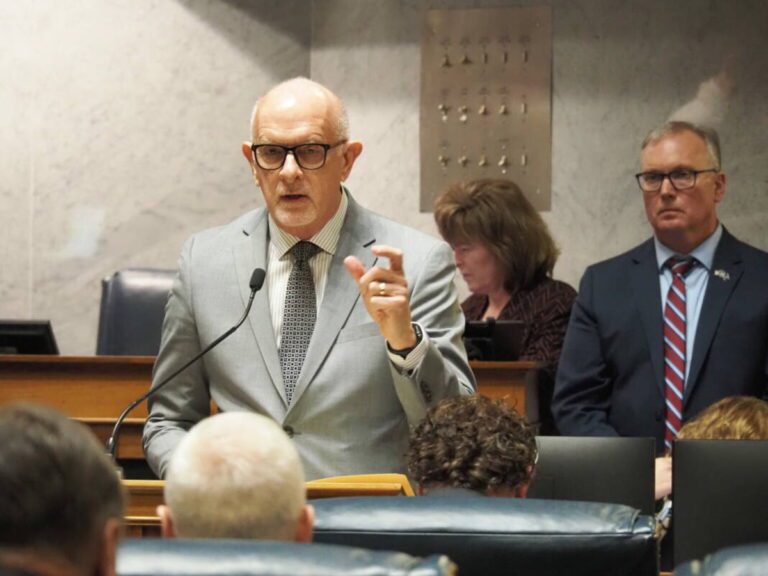🎧 Listen to This Article
The Indiana Senate recently passed a significant property and income tax reform package, setting the stage for Governor Mike Braun to sign it into law. This momentous move, though hailed by some as historic, has sparked considerable debate, with its potential long-term ramifications reaching beyond just the immediate fiscal relief.
In a late-night vote that followed extensive deliberation, the Senate passed Senate Bill 1, which promises property tax cuts for homeowners, farmers, and businesses alike. Governor Mike Braun, having initially expressed reservations about the legislation, has now committed to signing it, citing it as a core component of his “Freedom and Opportunity Agenda.” But while the bill offers substantial savings for many Hoosiers, it also brings to the forefront significant questions about its long-term impact on local communities, schools, and taxpayers.
Read More: Indiana Lawmakers Refine Property Tax Plan
What Does Senate Bill 1 Mean for Indiana’s Economy?
At its core, Senate Bill 1 offers an estimated $1.2 billion in property tax relief over the next three years. This relief comes in the form of a 10% credit on homeowners’ property tax bills, capped at $300 per homestead. This strategy aims to ease the burden for homeowners across the state, especially in the wake of rising property taxes that have been a consistent source of frustration for Indiana residents.
However, the bill’s benefits are not without their trade-offs. Local governments are projected to lose up to $1.5 billion in revenue by 2028, with public schools bearing the brunt of this loss. The fiscal analysis suggests that K-12 school districts alone could see a shortfall of $744 million, although some estimates indicate that the actual loss may be closer to $800 million. This raises crucial questions about how schools will continue to fund essential services. Will local income tax hikes be the only option? Or will local governments need to implement severe cuts to vital services, especially those impacting education and infrastructure?
The Politics of Tax Relief: Who Wins and Who Loses?
The debate surrounding the bill has been contentious. Republicans have championed the legislation as a victory for homeowners, emphasizing that two-thirds of homeowners will see lower tax bills by 2026. Meanwhile, they also argue that revenue for most local units will still increase, albeit at a slower rate than current projections suggest. Cities like Fort Wayne, for example, are expected to see property tax revenue rise from $167 million in 2025 to $187 million by 2028.
However, the bill’s opponents, particularly Senate Democrats, argue that the tax relief package creates a situation where certain groups, such as schools and renters, are left out or disadvantaged. Democrats like Sen. Andrea Hunley (D-Indianapolis) have warned that the bill does not go far enough to mitigate the adverse effects of these cuts on local services. This concern is compounded by the bill’s impact on renters, who, while not directly responsible for property taxes, will likely see landlords pass the tax burden onto them through higher rents.
Furthermore, the bill contains provisions that could shift the financial burden onto local income taxes, which are now capped at 2.9% for all counties, down from 3.75%. This presents local governments with a difficult choice: raise income taxes or cut essential services. As Sen. Greg Taylor (D-Indianapolis) pointed out, this could result in local municipalities slashing services such as road maintenance and public safety to avoid income tax hikes, ultimately harming the quality of life for residents.
Local Governments and the Push for Efficiency
The bill’s supporters argue that it will prompt local governments to rethink their budget allocations, trimming inefficiencies and reassessing expenditures before resorting to tax increases. Sen. Travis Holdman (R-Markle), the bill’s author, emphasized that local governments should strive to optimize their spending before raising taxes. While this may be a sound fiscal strategy in theory, it raises a critical question: Are local governments prepared to make the necessary cuts without undermining essential services?
The inclusion of a new business personal property tax exemption threshold—raising the threshold from $80,000 to $2 million—has also been met with mixed reactions. This change would exempt more small businesses from property taxes, which may provide some relief to entrepreneurs but could further exacerbate revenue shortfalls at the local level.
What Are the Next Steps?
While the immediate future appears to favor those seeking property tax relief, the longer-term effects of Senate Bill 1 remain uncertain. The bill’s potential to create fiscal stress for local governments, especially schools, will likely be a point of contention in the coming years. As businesses and local governments navigate the complexities of these tax changes, it will be essential for policymakers to monitor the economic fallout and adjust policies to ensure that the state’s fiscal health remains intact.
From a broader perspective, this reform package could serve as a microcosm of the ongoing debate over tax policy in the United States: how to balance tax relief for individuals and businesses with the need to fund public services that are essential to the well-being of communities.
What Should Businesses and Taxpayers Do?
For businesses, particularly small businesses, the new tax exemptions could provide welcome relief. However, they should remain vigilant about potential local tax increases and be prepared to adapt to the changing fiscal landscape. On the other hand, homeowners and farmers should take advantage of the property tax relief but keep an eye on potential increases in local income taxes.
For local governments, especially school districts, strategic planning and budget optimization will be critical. Engaging with constituents and advocating for reforms that address the needs of both taxpayers and public services will be essential to ensuring the sustainability of local government finances.
For further details, clarification, contributions, or any concerns regarding this article, please contact us at editorial@tax.news. We value your feedback and are committed to providing accurate and timely information. Please note that our privacy policy will handle all inquiries



